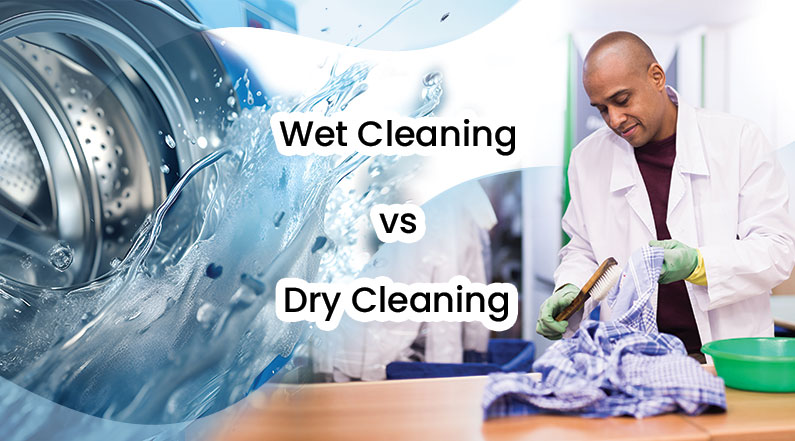
Content Head
Wet Cleaning Vs Dry Cleaning?
Wet cleaning or Dry cleaning? Do you know the difference? Why do you need one or the other? Determining which cleaning method - dry cleaning or wet cleaning is better for your clothing depends on a few things, including the material of your clothing and the type of stain.

Let's just understand the definition of “dry cleaning” as a technique.
What is Dry Cleaning?

Dry Cleaning, as the name implies, is a technique where clothing and laundry items are cleaned using solvents other than water. These solvents, like hydrocarbons, are often chosen for their eco-friendly properties.
What is Wet Cleaning?

Wet cleaning uses water based solvents that are typically non toxic and don't include chemicals. This method allows professional cleaners to determine the precise balance of heat and water to clean clothes without shrinking.
Pros and Cons of Wet Cleaning and Dry Cleaning
Let's explore the pros and cons of both these methods
Pros of Dry Cleaning:
- Effective on Stubborn Stains: Dry cleaning can remove tough stains that regular washing might struggle with.
- Gentle on Fabrics: It's less likely to cause shrinking or distortion in delicate fabrics.
- Fast Drying: Clothes dry quickly after the process.
- Spot Treatment: Ideal for treating specific problem areas.
Cons of Dry Cleaning:
- Expensive: Dry cleaning services can be costly.
- Chemicals and Perfumes: Some solvents used in dry cleaning contain chemicals and fragrances.
- Residue Buildup: Over time, residues from dry cleaning solvents can break down fabric fibers.
- May Not Provide Deep Clean: It might not thoroughly clean heavily soiled items.
Remember, while dry cleaning has its advantages, it's essential to consider the fabric type, stain severity, and cost when deciding whether to use this method1. If you have any specific stains, be sure to inform your cleaner for the best treatment!
Pros of Wet Cleaning:
- Eco-Friendly: Wet cleaning uses water-based detergents and is more environmentally friendly than traditional dry cleaning, which relies on chemical solvents.
- Vibrant Colors: Garments may retain their vibrancy better due to the absence of harsh solvents.
- Softer Fabric Feel: Wet cleaning often leaves fabrics feeling softer compared to dry cleaning2.
Cons of Wet Cleaning:
- Stretching or Warping: Improper training, faulty equipment, or incorrect handling can lead to clothing stretching or warping due to the weight of water2.
- Longer Drying Time: Wet cleaning requires more time for garments to dry compared to dry cleaning3.
Remember, wet cleaning is an innovative approach that balances environmental responsibility with fabric sensitivity. It's particularly suitable for delicate fabrics and offers a safer alternative to traditional dry cleaning methods.
Which Type Of Cleaning Is Best For Which Garments?
The type of cleaning process that is best for your garments depends on the type of fabric and how heavily soiled it is. Dry-cleaning is typically used for delicate fabrics like wool, silk, and feathers because it uses chemicals that are less likely to damage these types of materials.
Wet-cleaning, on the other hand, can be used on any type of fabric but will not remove stains as well as dry-cleaning. Wet cleaners typically use water or steam to remove dirt and other contaminants from clothes.
Choose the type of cleaning based on factors such as fabric type, stain composition and environmental impact.
Conclusion
Both dry and wet techniques are effective in removing stains and odors from clothes, but the differences between the two can help you decide which to choose. Looking for the best Laundry Pickup Service near me? Get in touch with us for professional wet and dry cleaning at affordable prices.
Discussion
Very straight-to-point article. Really worth time reading. Thank you!
Much appreciated! ☺️